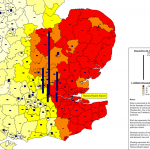SERAS review of Thames Reach Airport by Halcrow – December 2003 has been carried out on behalf of the DfT to assess the Thames Reach Airport proposals in detail and forms part of the basis for the findings in the government White Paper on aviation:
The White Paper ‘The Future of Air Transport’, published on 16 December 2003, sets out a strategic framework for the development of airport capacity in the United Kingdom over the next 30 years, against the wider context of the air transport sector.
It does not itself authorise or preclude any particular development, but sets out a policy framework which will inform decisions on future planning applications, and against which the relevant public bodies, airport operators and airlines can plan ahead. It sets out the conclusions of the Government, and of the devolved administrations where appropriate, on the case for future expansion at airports across the country. In doing so, it takes account of all relevant factors, including views expressed in an extensive consultation exercise which attracted over 500,000 responses.
Extract of the 2003 White Paper:
page 133
Alternative proposals
11.106 In the second edition of the consultation document and elsewhere the Government made clear it was open to, and would consider, any serious and worked-up alternative ideas. The following proposals were considered:
- Goodwin Sands – a new island airport east of Deal in Kent comprising two sites, each with two runways, with a total capacity of 120mppa.
- London Oxford – a new four-runway airport near Abingdon in Oxfordshire, with a capacity of 120mppa.
- Marinair – a new four-runway island airport in the Thames Estuary north east of the Isle of Sheppey.
- Redhill – development of Redhill aerodrome into an airport capable of handling 15mppa.
- Sheppey – a new two-runway airport on the Isle of Sheppey in Kent with a capacity of 75mppa and the potential to grow to four runways beyond 2030.
- Thames Reach – a new four-runway airport on the Hoo Peninsula in Kent (close to the Cliffe option), with a potential capacity of 120mppa.
page 135
11.114 Although the Thames Reach promoters managed to mitigate some of the drawbacks of Cliffe, a substantial part of the airport site would impact, as did Cliffe, on areas of very high ecological value that are protected under the EC Habitats Directive, and we have doubts whether the passenger numbers envisaged could be handled within the land-take given the likely demand for air travel over the day. We were concerned that the surface access proposals were not robust and over-dependent on rail. In the light of the appraisal of the Cliffe option, there remain significant concerns about the risk of bird strike and the efficacy of the measures proposed to address it. The capital costs assumed by the promoters are much less than those for Cliffe, including for surface access.




